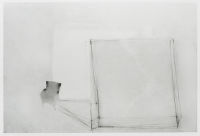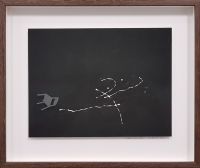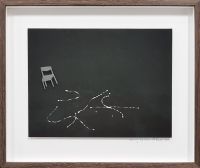"Drawing by Chairs #56"
C-print (Thermography)
In a concrete and real space, an armchair is moved and the thermal track is recorded, which in turn produces an abstract image. Thus Reusse poses the fundamental question of the meaning of concrete and abstract.
"In the process of creating the "thermovisions", photography and thermography are combined. Thermography is a process analogous to photography. While the camera records light waves, the thermograph depicts heat differences. The device consists of a heat sensor with a connected computer. The computer converts the sensor data into a visual image that can be viewed on the computer screen. Reusse photographs this screen image with a camera to obtain a negative from which he can have his cibachromes made. Shapes with low temperatures appear on the screen of the thermograph in bluish colours, high ones in shades between orange and white. In order for the thermograph to image something, an object does not necessarily have to be present. It is sufficient if it has left a warm aura. And this also applies to phenomena that are invisible from the start, such as breathing air or a fart. Photo historians will therefore classify a good part of "thermovisions" as "phantom images". While art historians are likely to place them in the context of "forensics".
(Prof. Gottfried Jäger, in: The Art of Abstract Photography)







